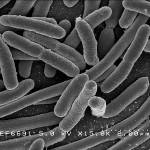Crowdsourcing Helping to Stop a Killer Bacterium in its Tracks
 E. coli (Escherichia coli) is a common bacterium that lives in the human gut. Most of the time, it’s a useful fellow, helping us to digest our food among other things. Most strains are harmless. But in some situations they can turn nasty and cause disease. On occasion they can be fatal.
E. coli (Escherichia coli) is a common bacterium that lives in the human gut. Most of the time, it’s a useful fellow, helping us to digest our food among other things. Most strains are harmless. But in some situations they can turn nasty and cause disease. On occasion they can be fatal.
One of the biggest outbreaks of E. coli in decades occurred in 2011. An unusual strain claimed 50 lives and hospitalized more than 4,000 others across Europe. Its source was unknown. To get some answers quickly, scientists turned to crowdsourcing.
The Beijing Genomics Institute in China made its DNA sequence of E.coli public domain, releasing it on the Internet to the international community.
This allowed scientists all over the globe to try and work out where the strain came from and how it turned into a killer.
One of those scientists was Dr. Nick Loman from the University of Birmingham. He started to analyse the data and posted sequences on his pathogen blog. Within a few days scientists from four continents were joining in with the analysis.
Race Against Time
As the outbreak was in full swing there was a sense of urgency. Researchers worked round the clock to crunch numbers, analyse data and build sequences.
The net result of this frenzied activity was the discovery that a bacteriophage toxin was responsible for the virulence factors and unusual deadliness of this strain.
Crowdsourcing had uncovered some of the answers in a much quicker time frame.
Science often trundles along at a very slow pace. Research can take years before conclusions are drawn and papers published. But this crowdsourcing initiative showed that it can move very quickly and respond to an ongoing outbreak.
Add your Comment
[LOGIN FIRST] if you're already a member.fields are required.
